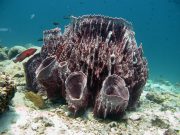Diving with Massive Sponges
Lanta Marine Life | Petrosiidae
Sponges of the Petrosiidae family are massive, vase-shaped or volcano-shaped sponges, sometimes encrusting, bulbous, and less commonly branching growth forms. Massive sponges are found at almost every site on our Koh Lanta diving trips.
Around Koh Lanta, the most obvious family member is the Giant Barrel Sponge, which is found on all of our coral reefs.
The texture is usually stony and brittle due to most species having more spicules (very small sharp-pointed spines) than spongin, which is the fibrous substance found in the skeleton of many sponges.
The outer layer of massive sponges are covered in these small sharp pointed spines, which form a pattern of interlacing lines resembling a net. This covering creates a crust which gives the surface of the sponge a smooth appearance.
1 species found on this page:
Giant Barrel Sponge
(Xestospongia muta)

Giant Barrel Sponge @ Koh Haa
The Giant Barrel Sponge can grow well over 1 m in diameter and is typically brownish-red to brownish-grey in shallow water, becoming more pinkish with depth. This species has a hard, stony texture and can grow for hundreds, even thousands of years.
This species has a varied form, often a very large barrel-like shape, slightly cone-shaped at the top. Shapes of individual sponges within colonies can vary widely from short to tall, thin to wide, with the surface being smooth, rough or rugged.
The sponges lives symbiotically with cyanobacterial, bacteria that obtain their energy through photosynthesis, which gives colour to the sponge. This is a similar relationship to that of coral polyps living with symbiotic algae.
The Giant Barrel Sponge undergoes sporadic bleaching events which do not cause sponge death, and from which the sponge recovers. This is part of the normal life cycle of this sponge and demonstrates that the sponge does not depend on the symbiotic bacteria to exist. Bleaching events occur more often with depth, and the reason for these events is not yet fully understood.
Diving with Massive Sponges around Koh Lanta
Scuba Diving & Snorkel Trips
If you'd love a chance to spot Massive Sponges on one of our daily high season diving trips from Koh Lanta then send us an email to info@diveandrelax.com.
Join our high season speedboat dive trips to some of Thailand's best dive sites and enjoy small groups, short journey times, with a focus on great personal service, safety and fun.
Not yet a certified diver? Learn to Scuba Dive on Koh Lanta with the 3 day SSI Open Water Diver course.
Book online to save 10% on dive trips and scuba courses on Koh Lanta.
Find Out More
Indo-Pacific Marine Life Guides
- Allen, G., Steene, R., Humann, P., DeLoach, N. (2003) Reef Fish Identification, Tropical Pacific. Jacksonville, FL., USA: New World Publications, Inc., ISBN 1-878348-36-1.
- Humann, P., DeLoach, N., (2010) Reef Creature Identification, Tropical Pacific. Jacksonville, FL., USA: New World Publications Inc., ISBN 978-1-878348-44-9
- Debelius, H. (2013) Indian Ocean Reef Guide. Frankfurt, Germany: IKAN - Unterwasserarchiv, ISBN 978-3-939767-52-7.
- Debelius, H. (2004) Nudibranchs and Sea Snails, Indo-Pacific Field Guide. Frankfurt, Germany: IKAN - Unterwasserarchiv, ISBN 3-925919-51-1
- Erhardt, H., Knop, D. (2015) Corals Indo-Pacific Field Guide. Frankfurt, Germany: IKAN - Unterwasserarchiv, ISBN 3-925919-69-4.
- Veron J.E.N., Stafford-Smith M.G., Turak E. and DeVantier L.M. (2016). Corals of the World
